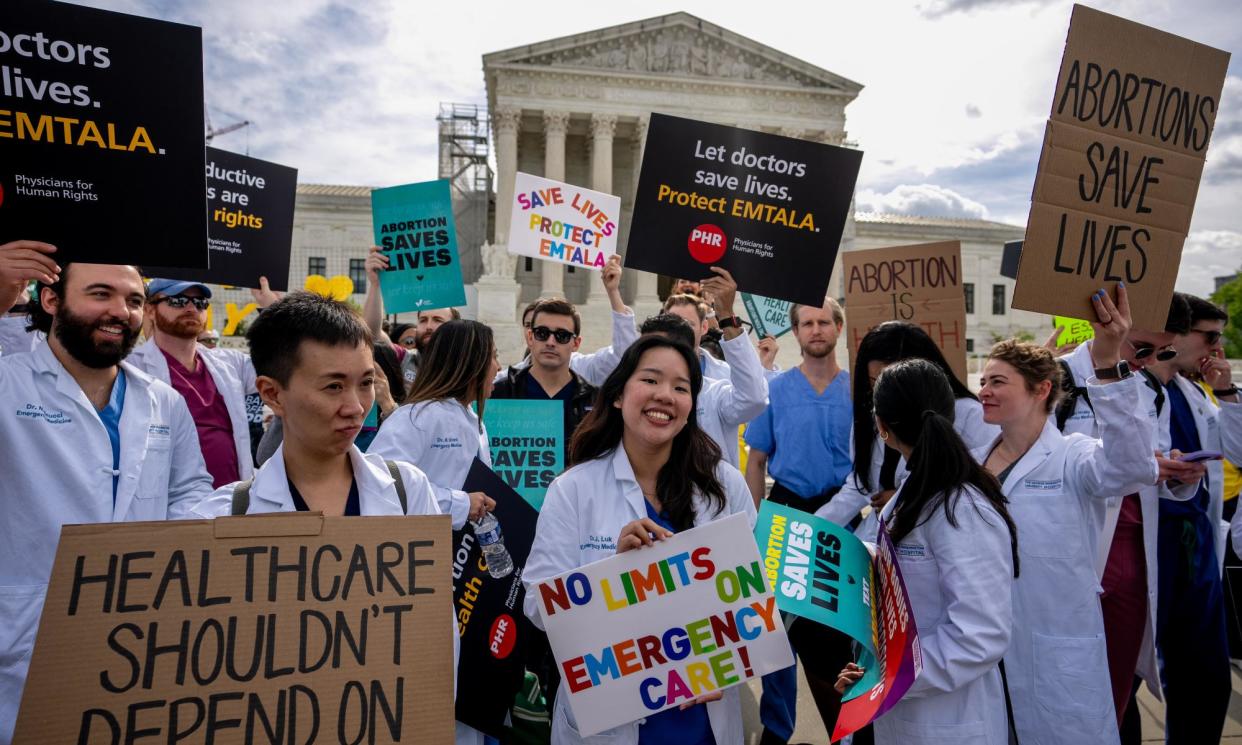What’s at stake in emergency abortion care case before US supreme court?

The supreme court heard its second abortion rights case of the term on Wednesday, this one focused on how states can regulate emergency abortions – exceedingly rare procedures that often save a woman’s life or her future fertility.
The case may seem technical because it focuses on a small subset of emergency abortions and federal law that governs emergency room care.
However, if the court finds in favor of anti-abortion states, it could upend emergency care for millions of pregnant women and undermine the federal government’s ability to regulate emergency medicine.
Here’s what you need to know about the law
The Emergency Medical Treatment and Active Labor Act (Emtala) is a federal law that requires doctors and hospitals to provide stabilizing treatment to patients facing serious threats to life and limb, regardless of their ability to pay, or lose federal funding.
The law grew out of “patient dumping” in the 1980s, when private hospitals transferred patients who could not pay, including women in active labor, to public counterparts.
Idaho’s strict abortion ban only allows doctors to intervene in near-death cases
Emtala requires doctors to stabilize patients if they face a threat to life or limb. If a patient’s health could be seriously impaired in the future – for example, if a pregnant woman could lose her uterus unless she receives an abortion – an emergency room must make an effort to treat that threat to health.
This requirement directly conflicts with Idaho’s abortion ban, which only allows doctors to terminate a pregnancy to prevent death. Otherwise, doctors could face prosecution and loss of their medical license.
So, how can healthcare providers comply with Emtala and Idaho’s law? Lawyers for Idaho say there is no conflict. Because doctors must work within the bounds of state licensing boards, Idaho’s attorneys said they could comply with Emtala by simply following Idaho’s imminent death standard.
Female justices appeared especially skeptical. Justice Amy Coney Barrett, a member of the conservative wing, asked Idaho’s deputy solicitor general, Joshua Turner, if a doctor would face criminal charges if they treated a woman who could lose her uterus but not die. Not if a doctor was “exercising their medical judgment to determine life-saving care was necessary”, Turner said.
“What if the prosecutor thought differently?” asked Coney Barrett.
“That is the nature of prosecutorial discretion,” said Turner.
The federal government says Idaho’s law is dangerous
Lawyers for the federal government vehemently disagreed and Turner’s assurances that doctors could exercise medical judgment do not square with reality, said the Biden administration’s solicitor general, Elizabeth Prelogar.
“Idaho has directly interfered with the ability of hospitals to accept these federal funds and fulfill Congress’s desire that no matter where you are in this country you can go to an ER and be stabilized,” said Prelogar.
Doctors in Idaho are so scared of treating pregnant patients that the state’s largest emergency care department is regularly airlifting women to Utah, Prelogar said. Utah also has an abortion ban, but it makes an exception for women’s health, and therefore does not conflict with Emtala. At least six more states have abortion bans that do not make an exception for women’s health, Prelogar said, though not all are in effect.
Herein lies some of this case’s most pernicious implications – if doctors do not feel safe, then treating any pregnant patient in an abortion ban state becomes a high-risk proposition. It means women will be and already are being turned away from emergency rooms – endangering one of the populations Congress sought to protect.
The court appears divided
Whether the court will side with anti-abortion states or the federal government is unclear. The court’s three liberals are almost certain to vote against anti-abortion states. At least one conservative, Coney Barrett, also appeared skeptical.
The conservative justices Samuel Alito and Clarence Thomas appeared supportive of Idaho. The votes of three more conservative justices are less clear. Liberals will need at least two conservatives to join them to protect emergency care as Americans know it today.

 Yahoo News
Yahoo News 
